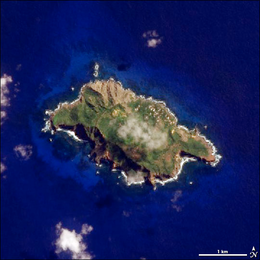Pitcairn Island
Contributors to Wikimedia projects
 Article Images
Article Images
Pitcairn Island is the only inhabited island of the Pitcairn Islands, in the southern Pacific Ocean, of which many inhabitants are descendants of mutineers of HMS Bounty.[1]
 Satellite image | |
| Geography | |
|---|---|
| Location | Pacific Ocean |
| Coordinates | 25°04′00″S 130°06′24″W / 25.06667°S 130.10667°W |
| Archipelago | Pitcairn Islands |
| Area | 4.5 km2 (1.7 sq mi) |
| Length | 3.5 km (2.17 mi) |
| Width | 1.8 km (1.12 mi) |
| Highest elevation | 346 m (1135 ft) |
| Highest point | Pawala Valley Ridge |
| Administration | |
United Kingdom | |
| Demographics | |
| Population | 40 (2024) |
| Pop. density | 10/km2 (30/sq mi) |
The island is of volcanic origin, with a rugged cliff coastline. Unlike many other South Pacific islands, it is not surrounded by coral reefs that protect the coast. The only access to the island is via a small pier on Bounty Bay. Adamstown is the sole settlement.
Pawala Valley Ridge is the island's highest point at 346 m above sea level.
The volcanic soil and tropical climate with abundant rainfall make the soil productive.
The average temperature ranges from 19 to 24°C. The annual rainfall is 1,800 mm.[citation needed]
Indigenous fauna consists of insects and lizards. Since their introduction, rats have become an invasive species.
A large number of seabirds nest along the steep shorelines.[2]
As coral reefs are absent, fishing is offshore. Sharks, sea bream, barracudas and tuna are all abundant. Whale migrations are seen yearly.
History and population
-
Church
-
Longboats
-
Pier
-
St Paul’s Point (east coast)
-
Indigenous vegetation at Garnets Ridge
-
Southwest
-
St Paul’s pool
- ^ Johnson, Christine (2014). "The Identity of Place: Pitcairn Island in Cultural and Historical Geography". University of Nevada, Reno. hdl:11714/2838. Retrieved 15 June 2022.
- ^ Albert, Donald Patrick (3 July 2018). "Did or Could Seabirds "Halo" Pitcairn Island for Fletcher Christian?". Terrae Incognitae. 50 (2): 99–114. doi:10.1080/00822884.2018.1498638. ISSN 0082-2884.
